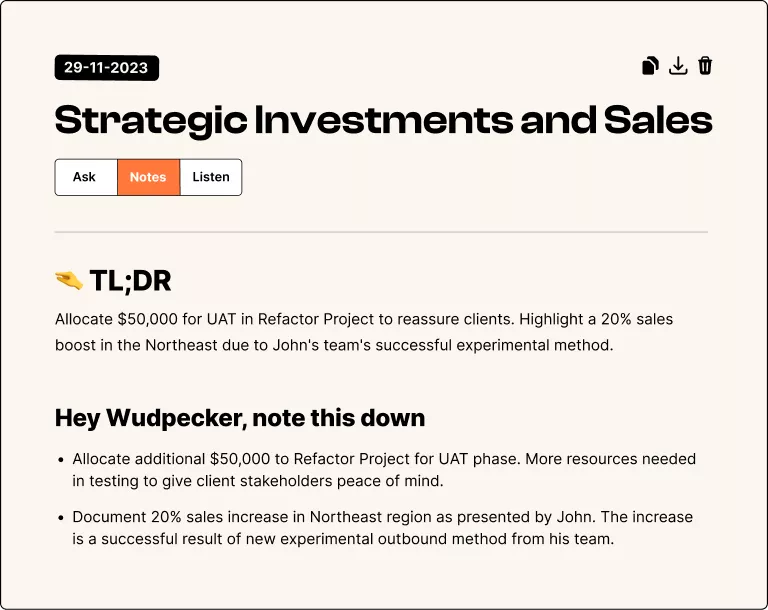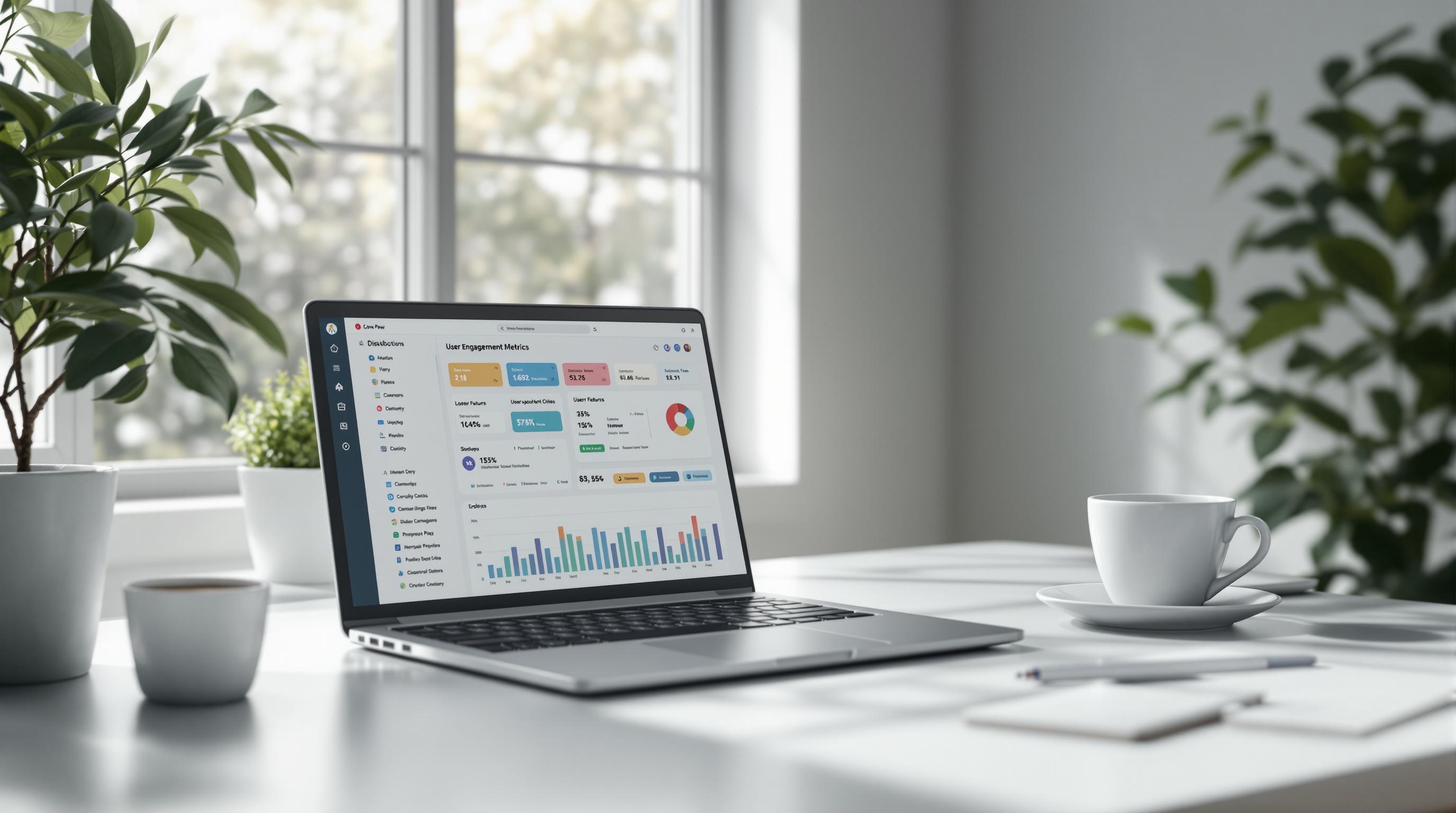Most organizations would agree that capturing insights from meetings can be incredibly valuable, yet challenging to put into practice.
Luckily, by implementing simple strategies and software solutions, teams can effectively manage meeting takeaways for greater productivity and alignment.
In this post, we'll explore the role of meeting takeaways in knowledge management, provide examples and best practices for writing key takeaways, and review software tools to help organize insights for future reference and action.
Capturing and Managing Meeting Takeaways
Effective knowledge management is critical for organizational productivity. Meetings generate valuable insights, decisions, and action items that must be accurately captured and organized to drive progress. However, manually tracking meeting takeaways is time-consuming and prone to information loss.
Understanding the Value of Meeting Takeaways
- Meeting takeaways encapsulate the key discussion points, agreements, next steps and responsibilities that emerge.
- Consolidating this knowledge ensures alignment across teams and stakeholders.
- Structured organization and easy retrieval of this information is essential for executing priorities discussed.
- Without centralized access to past meeting takeaways, productivity suffers from miscommunication and unclear objectives.
Challenges in Knowledge Management
- Note-taking difficulties during meetings lead to incomplete or inaccurate capture.
- Details get lost across multiple systems like emails and chats.
- Version control issues arise when documents are passed around.
- Searching past notes for specific insights becomes laborious.
- Onboarding new members requires manual transfer of historical knowledge.
What are takeaways examples?
Takeaways are the key conclusions, impressions, or action points that result from a meeting, discussion, or other collaborative session. Some examples of effective meeting takeaways include:
- Decisions made: Document any choices the team came to regarding next steps, resource allocation, project plans, etc.
- Action items: Note any tasks that need to be completed, who is responsible for each, and by what date they are due.
- Key insights: Summarize important discoveries, light bulb moments, or revelations uncovered during the discussion.
- Open questions: Log any unanswered questions or uncertainties that require further investigation.
- Feedback received: Record constructive commentary from meeting participants to inform future improvements.
- Lessons learned: Identify best practices or pitfalls experienced to apply to future meetings and projects.
The goal of capturing takeaways is to retain the most vital information from collaborative sessions to inform follow-up work. With clear documentation of conclusions, next steps, and insights, teams can progress projects more efficiently.
Tools like Wudpecker help automatically generate takeaways summaries from meetings, ensuring important details are not lost. Their AI meeting assistant technology can identify key discussion points, extract action items, and enable easy search and retrieval of meeting knowledge. This saves manual effort while enhancing productivity.
sbb-itb-6285ddb
Strategies for Organizing Meeting Insights
Organizing meeting insights is key to driving productivity and aligning teams. Here are some effective strategies:
Implementing Effective Meeting Takeaways Templates
Using templates is an excellent way to capture meeting takeaways consistently. Some best practices include:
- Meeting takeaways template should have sections for decisions, action items, questions, risks, and key insights.
- Leave room for notes under each section during the meeting.
- Circulate the template to attendees beforehand so everyone knows what to expect.
- Examples of good templates make sections for meeting name, date, attendees, agenda items, decisions, discussion highlights, action items, questions, etc.
Software Solutions for Centralized Knowledge Storage
Software tools like Wudpecker offer centralized repositories to access and organize meeting insights:
- Store meeting recordings, transcripts, summaries, and takeaways in one place.
- Add tags and metadata for quick search and retrieval.
- Integrate permissions to control confidential data access.
- Software solutions enable managing knowledge at scale.
Integrating Takeaways into Productivity Workflows
Incorporating meeting takeaways into workflows is essential for productivity:
- Share key decisions and action items with stakeholders.
- Transfer action items into task management tools like Asana or Jira.
- Analyze takeaways to uncover organizational goals and roadblocks.
- Use takeaways during onboarding and sales training materials.
- Automate follow-ups based on meeting commitments.
Following these steps will lead to improved meeting outcomes and enhanced team alignment. The key is consistency and integration with existing systems.
Mastering the Art of Writing Key Takeaways
Meetings often generate valuable insights, decisions, and action items that need to be clearly communicated to stakeholders. However, capturing meeting takeaways can be challenging. Using tools and best practices to craft impactful key takeaways enables teams to align quickly and drive productivity.
How to Write Key Takeaways: Examples and Best Practices
Writing effective meeting takeaways requires focus on clarity, brevity, and relevance. Follow these best practices:
- Highlight decisions and actions - Emphasize key decisions made and essential next steps. This provides focus for follow-up work.
- Use simple language - Avoid complex terms or acronyms. Keep takeaways easy to digest.
- Prioritize relevance - Only include insights useful to intended audience. Leave out extraneous details.
- Be concise - Summarize points in 2-3 sentences. Remove fluff words.
- Add context - Provide brief background to aid understanding of why decisions were made.
For example, a key takeaway could state:
Decided to launch email campaign targeting high-value customers by EOM based on positive ROI data. John to draft campaign content by Friday.
This takeaway is clear, actionable, and relevant.
Ensuring Clarity and Relevance in Takeaways
To maximize impact, takeaways must communicate required information clearly and concisely.
- Define next steps - Clearly indicate what needs to happen after the meeting and who owns specific follow-ups.
- Set deadlines - Include actionable deadlines to drive accountability.
- Tailor messaging - Adjust detail level based on audience needs. Technical groups may require more context than executives.
- Review and refine - Edit takeaways to remove ambiguous language, ensure clarity of decisions.
With clear, tailored key takeaways, teams can move initiatives forward quickly.
Leveraging AI for Automated Takeaway Generation
AI meeting assistants like Wudpecker provide automated and customizable meeting takeaways.
Benefits include:
- Automated transcription - Convert meeting conversations into accessible transcripts.
- Summary generation - Highlight key discussion points and decisions.
- Customization - Tailor summaries based on audience needs.
- Productivity focus - Emphasize action items to drive workstreams forward.
- Data security - Ensure insights stored securely with encryption.
With AI takeaway generation, teams can efficiently unlock meeting insights.
Conclusion: Harnessing Meeting Takeaways for Organizational Success
This final section summarizes the key insights on how meeting takeaways, when properly managed through the right tools and practices, can significantly contribute to knowledge management and productivity goals.
Recap of Meeting Takeaways Ideas and Practices
Meeting takeaways provide a valuable opportunity to capture key insights and decisions from meetings. Some best practices include:
- Identifying 3-5 main takeaways from each meeting
- Highlighting important facts, action items, and next steps
- Circulating takeaways to align all stakeholders
- Storing takeaways securely for future reference
- Reviewing takeaways at the start of the next meeting
Following these practices ensures critical knowledge is retained and put into action.
Selecting the Right Knowledge Management Platform
When selecting software to assist with meeting takeaways, consider solutions that:
- Integrate with your existing workflow tools
- Allow collaboration from multiple team members
- Provide searchable and secure document storage
- Offer AI-powered meeting summaries and analytics
- Emphasize data privacy protections
The right platform can automate meeting note-taking while aligning with your team's specific needs and processes.
Action Steps for Implementing Takeaways Management
To harness meeting takeaways:
- Audit current practices to identify gaps
- Set organization-wide guidelines for capturing takeaways
- Select suitable software to test and potentially adopt
- Train staff on processes and tools to ensure engagement
Following these steps will lead to productive meetings where insights are retained for future use.
Related Blog Posts



.svg)



















.svg)
